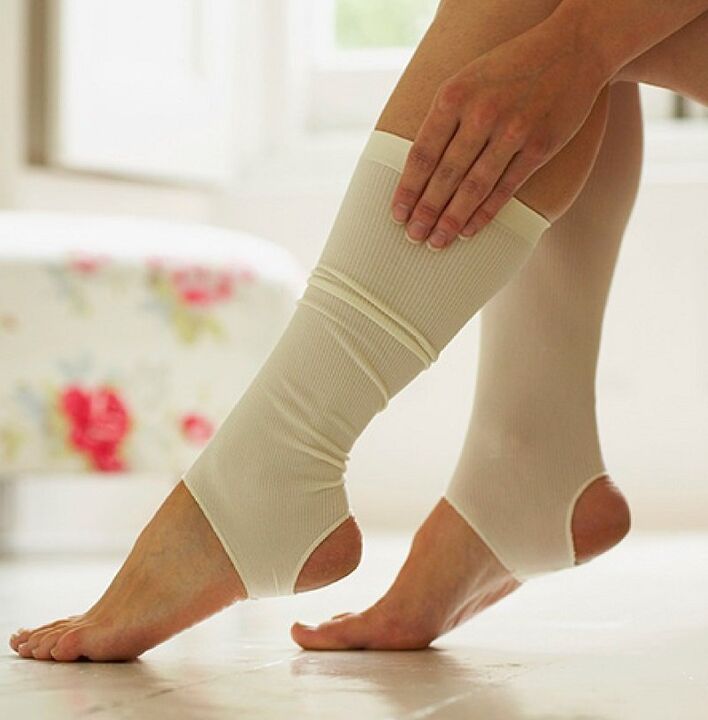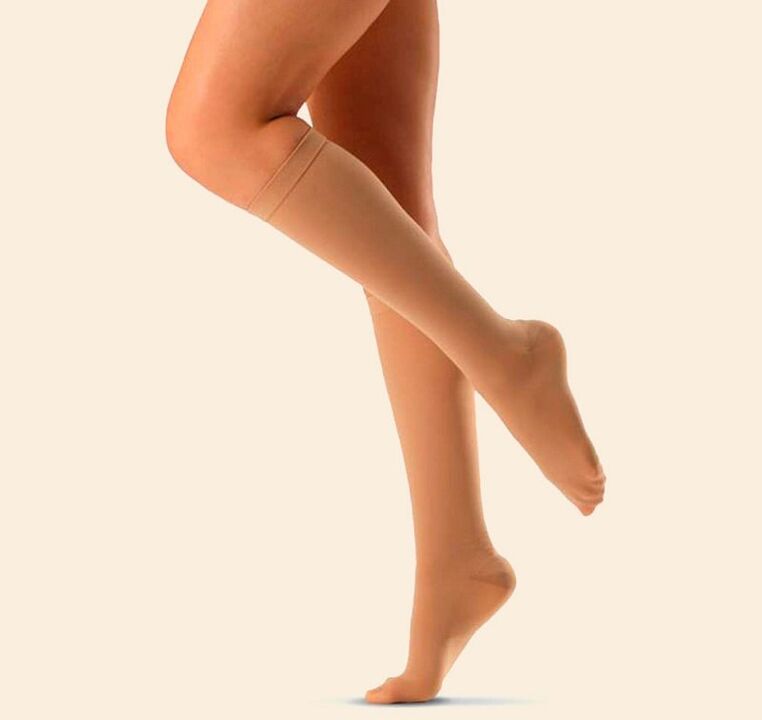Due to the anatomical conditions, human vessels consist of a layered wall and valves. With constant orthostatic action on the legs, there is an increase in diastolic pressure. Due to their elasticity, the vessels form varicose veins.
Compression underwear for varicose veins has the opposite effect. By distributing the pressure over the entire surface of the leg, it is possible to normalize the condition of the vessels. The diameter decreases and the blood flow is not hindered by branching vessels, the pressure drops.
Purpose of the compression garment
For varicose veins, arranging to wear compression stockings is the first step in treating the disease. The reason for the appearance of varicose veins is often a circulatory disorder and a lack of muscle tone. The presence of thrombophlebitis and other diseases of the vascular system contribute to complications of varicose veins.
The appointment may be required due to risk factors for varicose veins. These include:
- To do sports;
- Obesity;
- constant orthostatic pressure on the legs;
- Limb and cardiovascular system pathology.
Compression pressure in varicose veins is necessary to restore the tone of blood vessels, muscles and joints. And, if necessary, also normalize the flow of blood in the vessels and reduce the edema that occurs with varicose veins.
Compression garments relieve fatigue and pain in the limbs affected by varicose veins.
Despite the presence of varicose veins, compression stockings can be prescribed after the operation. In cases where varicose veins are treated surgically, the postoperative period is accompanied by compression of the extremity. This allows the vessels to recover and not waste elements on the stretching that will accompany after the procedures.
particularities
Compression garments are able to remove excess fluid, participate in heat transfer and generate the constant pressure necessary to relieve pain in varicose veins. Therapeutic underwear does not contribute to the appearance of allergic reactions, their materials do not participate in the reaction.
The material of the linen follows the contours of the body where necessary and adapts to it closely. Over time, the material becomes firmer and remembers the shape of the body.
Compression underwear for the treatment of varicose veins is sewn from microfiber, elastic materials: nylon and cotton fibers, Lycra. The tensile properties of these materials give the wearer compressive pressure.

The use of the product occurs only with the appointment of a phlebologist. This thoroughness only applies to laundry in classes 1 to 4 with a pressure of 24 millimeters of mercury. This is necessary to rule out damage to the vessels from improper use of compression.
Since prophylactic compression products have a pressure of up to 18 millimeters of mercury, their use is harmless to health and can be used without consulting a phlebologist.
When choosing underwear, you should be guided by a few criteria:
- Originality. It is important that the product comes from the original supplier. Inferior or poor materials are often used for counterfeits. This leads to improper compression or rapid product wear.
- The size. Proper size selection will ensure that compression therapy is correct.
- Use the required class. It is not recommended to use underwear of a class other than that specified.
All companies that manufacture compression stockings for varicose veins are based on the international standard. Before the start of production and after passing the test, the companies receive a certificate, which means that the product is really medical and is used for medical purposes.
All company representatives must have the right to sell products. If there is no such document, the product is not an original.
There is a separate certification for the class of anti-embolic underwear. Since such compression products are used exclusively for the treatment of a medical disease, companies are certified with a medical standard.
Classification and types
All compression products for the treatment of varicose veins are divided into the following characteristics: the degree of compression, the form of relief and the purpose of the appointment.
The classification distinguishes between four product classes:
- The first class is intended for neoplasms of varicose veins or for prophylactic purposes. The maximum class pressure is 23 millimeters of mercury.
- The second class is used to treat varicose veins or thrombophlebitis. The maximum pressure is 33 millimeters of mercury. The second class, with vasodilation, is applicable only to a mild form of the disease.
- The third class is indicated in acute venous insufficiency, as well as in violation of cell metabolism. The maximum pressure is 45 millimeters of mercury.
- The fourth grade relates to rehabilitation. Most often it is used for the postoperative period, when the vasculature and muscles are unable to independently maintain normal blood flow or there is a risk of provoking the appearance of varicose veins.
Special purpose:
- Hospital. It is used only during constant medical supervision during the postoperative period.
- Preventive. In cases when the first signs of diseases of the vascular system appear - varicose veins.
- Therapeutic. I am used to treat chronic diseases of the vascular system, eliminate symptoms.
As a rule, compression stockings with a pressure of 33 to 45 millimeters of mercury are used for medical purposes. Phlebologists consider this pressure optimal for therapy.
The range of compression underwear is wide, the manufacturers have models for women and men.
It is represented by the following types:
- Socks. Medical jerseys of this shape only have a length up to the thigh. The main purpose of its application is to get rid of swelling and varicose veins in the lower leg and thigh. Stockings help keep blood vessels in proper shape, which helps prevent blood vessels from clogging.
- Pantyhose. Compression tights look similar to normal products. Tights fit snugly across your entire leg - from your toes to your waist. Treatment includes: shins, thighs, and groin area. Tights are only recommended for widespread varicose veins above the knee joint.
- Knee socks and leggings. Knee socks only reach down to the lower leg area. This allows you to use point compression when varicose veins form only on the lower leg. Knee socks are very popular with pregnant women. Socks eliminate swelling and normalize blood circulation. The only difference between leg warmers and golf is the lack of socks. However, the effect is the same.
- Sleeve. Their primary purpose is to remove the buildup of lymphatic fluid that causes severe limb swelling. This often occurs after surgery on the upper body.
- During pregnancy. During pregnancy, compression stockings help relieve leg swelling and prevent symptoms of varicose veins.
Using compression garments during pregnancy relieves pressure on the lumbar area and allows you to maintain correct posture at all times. This promotes better oxygen exchange between the fetus and the mother.
How to choose the size
The size of compression garments for varicose veins is selected based on body measurements. It is not recommended to wear underwear that is larger or smaller than your doctor prescribes. Such wearing is uncomfortable and will worsen or not help the development of the disease.
Before buying, you need to measure:
- Ankle circumference;
- the circumference of the neck of the bottle just below the knee;
- Thigh circumference at a height of 25 to 30 centimeters;
- the total length of the leg from the heel to the groin;
- Waist and hip measurements.
The circumference of the thigh in people up to a height of 175 centimeters must be carried out at a height of 175 centimeters. Above this number, the countdown increases to 30 centimeters.

Only a phlebologist or a specially trained counselor can opt for compression garments.
After taking measurements, it is necessary to compare the results with the size table. Each manufacturer specifies this data on the packaging.
If the volume on the legs and waist does not correspond to the available sizes, then it makes sense to do without tights. Your use will have no effect. It is worth paying attention to leggings or stockings.
Wear recommendations
In order to achieve the maximum effect from the use of compression clothing, this is only possible with proper use. The treatment process will only continue if the jersey is worn properly.
To do this, you need to follow the recommendations:
- it is necessary to put on lines in a horizontal position in the morning;
- for simplicity, the upper part folds into an accordion and extends from the lower part;
- You need to start dressing first by lightly embroidering the area for the foot and toe.
- smooths the material without stretching it over the entire length of the thigh.
When using leggings or stockings, their tension must be limited to the average length when taut.
If edema occurs in varicose veins, or underwear with increased pressure is used, then a special device should be used for dressing.
Care instructions
With the long-term use of compression garments for the treatment of varicose veins, you should follow the rules for caring for compression garments:
- Laundry should only be washed in manual mode with a low alkali shampoo;
- the maximum water temperature should be in the range of 30 to 40 degrees;
- drying of the product is carried out only in a horizontal position and without direct sunlight, as well as without high temperatures;
- When using products with gel strips, avoid getting liquid on this tape as this will worsen the contact with the skin.
It is recommended to wear several compression stockings at the same time. It is thus possible to prevent the laundry from wearing out quickly.
The use of compression stockings is recommended for all people with frequent pressure on the extremities or after operations, which normalizes the pressure and improves blood circulation.
The variety of models and classifications allows you to individually approach the problem of choosing clothes. Caring for and using compression garments for varicose veins is not difficult. If all operating regulations are observed, it is possible to maintain the therapeutic properties of the material for up to 10 months.

























